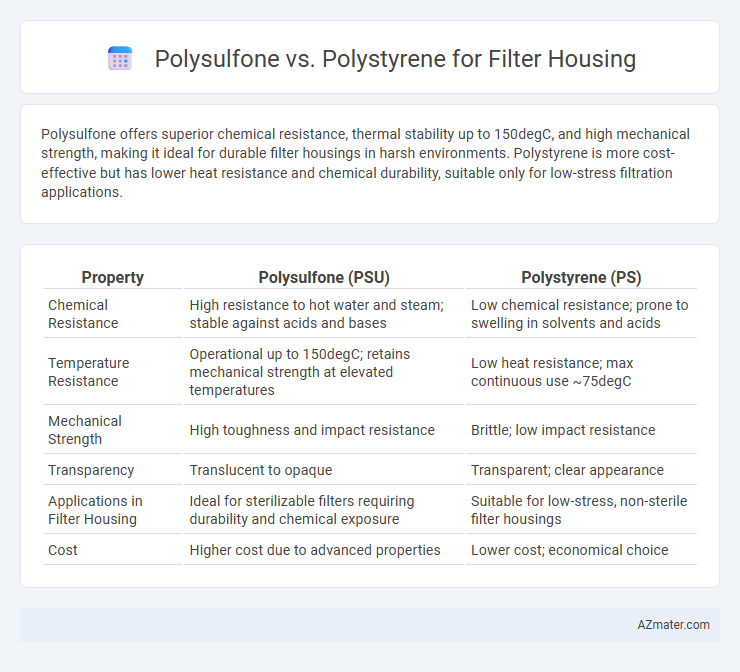Polysulfone offers superior chemical resistance, thermal stability up to 150degC, and high mechanical strength, making it ideal for durable filter housings in harsh environments. Polystyrene is more cost-effective but has lower heat resistance and chemical durability, suitable only for low-stress filtration applications.
Table of Comparison
| Property | Polysulfone (PSU) | Polystyrene (PS) |
|---|---|---|
| Chemical Resistance | High resistance to hot water and steam; stable against acids and bases | Low chemical resistance; prone to swelling in solvents and acids |
| Temperature Resistance | Operational up to 150degC; retains mechanical strength at elevated temperatures | Low heat resistance; max continuous use ~75degC |
| Mechanical Strength | High toughness and impact resistance | Brittle; low impact resistance |
| Transparency | Translucent to opaque | Transparent; clear appearance |
| Applications in Filter Housing | Ideal for sterilizable filters requiring durability and chemical exposure | Suitable for low-stress, non-sterile filter housings |
| Cost | Higher cost due to advanced properties | Lower cost; economical choice |
Introduction to Filter Housing Materials
Polysulfone offers superior thermal stability and chemical resistance, making it ideal for demanding filter housing applications in medical and industrial settings. Polystyrene, while cost-effective and easy to mold, lacks the robustness required for high-temperature or harsh chemical environments. Selecting the right material depends on operational conditions, with polysulfone preferred for durability and polystyrene suited for low-stress, disposable filter housings.
Overview of Polysulfone and Polystyrene
Polysulfone offers excellent thermal stability, chemical resistance, and durability, making it ideal for filter housing in demanding environments. Polystyrene, while cost-effective and easy to mold, lacks the high heat resistance and chemical toughness seen in polysulfone, limiting its use to less rigorous applications. The superior mechanical properties and longevity of polysulfone ensure reliable performance in industrial filtration systems compared to polystyrene.
Mechanical Strength Comparison
Polysulfone offers superior mechanical strength compared to polystyrene, making it more suitable for high-pressure filter housing applications. Its enhanced impact resistance and thermal stability allow polysulfone housings to withstand rigorous operational conditions without cracking or deforming. Polystyrene, while cost-effective, exhibits lower tensile strength and brittleness, limiting its use to less demanding filtering environments.
Chemical Resistance Analysis
Polysulfone exhibits superior chemical resistance compared to polystyrene, effectively withstanding exposure to acids, bases, and solvents commonly encountered in filter housing applications. Polystyrene tends to degrade or swell when exposed to aggressive chemicals, limiting its use in harsh environments. The enhanced chemical stability of polysulfone ensures longer durability and reliable performance in filtration systems exposed to varied chemical compounds.
Thermal Stability Differences
Polysulfone exhibits superior thermal stability compared to polystyrene, with a continuous use temperature around 150degC versus polystyrene's limit near 75degC. This makes polysulfone filter housings ideal for high-temperature applications and sterilization processes such as autoclaving. Polystyrene's lower thermal resistance restricts its use to environments with minimal heat exposure, affecting its durability and performance in demanding filtration systems.
Durability and Longevity
Polysulfone offers superior durability for filter housings due to its high thermal stability, chemical resistance, and impact strength, making it ideal for demanding industrial applications. Polystyrene, while cost-effective and lightweight, tends to be more brittle and less resistant to heat and chemical exposure, which may reduce its lifespan in harsh environments. Choosing polysulfone ensures longer longevity and consistent performance under extreme conditions, enhancing filter system reliability.
Cost and Economic Factors
Polysulfone filter housings generally have higher upfront costs than polystyrene due to superior thermal resistance and chemical durability, which enhance longevity and reduce replacement frequency. Polystyrene offers a lower initial price, making it suitable for budget-conscious applications but may incur higher long-term expenses from reduced durability and potential for deformation under stress. Evaluating total cost of ownership, including maintenance and lifespan, often reveals polysulfone as more cost-effective in demanding filtration environments.
Application Suitability in Various Industries
Polysulfone offers superior chemical resistance, high-temperature tolerance, and excellent mechanical strength, making it ideal for pharmaceutical, food and beverage, and medical device filter housings. Polystyrene, while more cost-effective and easier to mold, lacks the durability needed for aggressive chemicals and high-temperature environments, limiting its use to low-demand applications like water filtration and air purifiers. Industries requiring sterilization and repeated cleaning cycles favor polysulfone for its resilience and long service life under rigorous conditions.
Environmental Impact and Sustainability
Polysulfone filter housings exhibit superior environmental sustainability due to their higher heat resistance and longer lifecycle, reducing frequent replacements and waste generation compared to polystyrene. Polystyrene, while cost-effective, has a higher carbon footprint and limited recyclability, contributing more significantly to environmental pollution. Manufacturing polysulfone involves fewer volatile organic compounds (VOCs), thereby lowering its ecological impact and promoting sustainable water filtration solutions over polystyrene alternatives.
Conclusion: Choosing the Right Material
Polysulfone filter housings offer superior chemical resistance, thermal stability up to 150degC, and better mechanical strength compared to polystyrene, making them ideal for harsh industrial and medical filtration applications. Polystyrene is more cost-effective and suitable for low-temperature environments with less chemical exposure, typically in laboratory or food industry filters. Choosing the right material depends on balancing budget constraints with specific filtration conditions, where polysulfone provides durability and longevity while polystyrene fits lighter, less demanding uses.

Infographic: Polysulfone vs Polystyrene for Filter Housing
 azmater.com
azmater.com